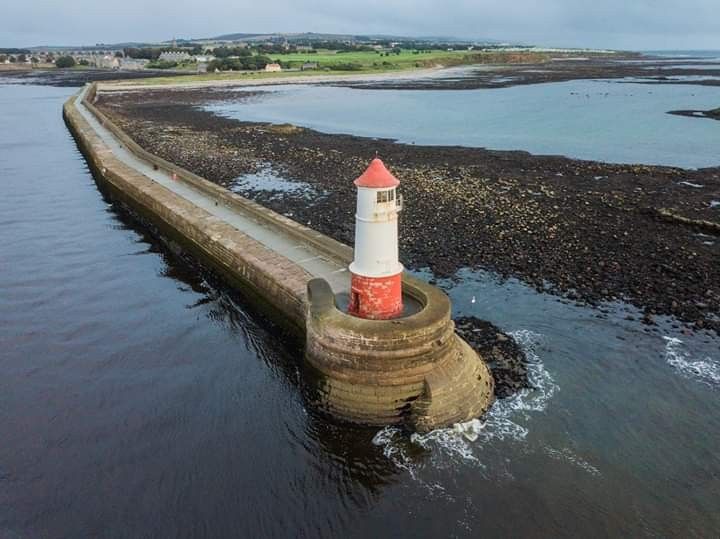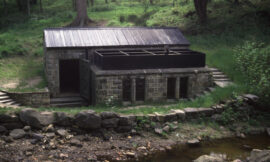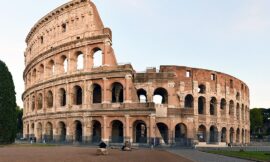Berwick Pier and Lighthouse are significant landmarks located in Berwick-upon-Tweed, a historic town on the northeast coast of England. These structures not only contribute to the town’s rich maritime heritage but also play vital roles in ensuring the safety and navigability of the waters around this coastal community.
Berwick Pier
Historical Background:
- Construction: Berwick Pier was constructed in the early 19th century to protect the harbor and town from the harsh North Sea conditions. The pier extends into the sea, providing a crucial barrier against waves and storms.
- Engineering: The design and construction of the pier involved considerable engineering expertise. It was built using robust materials to withstand the constant battering of the sea.
Function and Importance:
- Harbor Protection: The primary function of Berwick Pier is to protect the harbor and town from the impact of the North Sea. By breaking the force of incoming waves, the pier helps to maintain calmer waters within the harbor, reducing the risk of flooding and damage to vessels.
- Navigation: The pier also plays a role in aiding navigation. It provides a clear boundary for ships entering and leaving the harbor, helping to guide them safely through the often-turbulent waters.
Modern Use:
- Fishing and Leisure: Today, Berwick Pier is used for both commercial and leisure activities. Local fishermen use it as a base for their operations, while residents and tourists enjoy walking along its length, taking in the views of the sea and the town.
- Tourist Attraction: The pier is a popular spot for visitors to Berwick-upon-Tweed. It offers stunning views of the coastline and is an excellent vantage point for observing maritime activity and wildlife.
Berwick Lighthouse
Historical Background:
- Construction: Berwick Lighthouse, located at the end of the pier, was built in 1826. The lighthouse was an essential addition, providing much-needed guidance to ships navigating the dangerous waters of the North Sea.
- Design: The lighthouse is a relatively small structure, standing at 13 meters (43 feet) tall. Its simple yet effective design has allowed it to remain operational for nearly two centuries.
Function and Importance:
- Navigational Aid: The primary function of the lighthouse is to serve as a navigational aid. The light emitted from the tower helps to guide ships safely into the harbor, particularly during the night or in poor weather conditions.
- Safety: The lighthouse plays a crucial role in ensuring the safety of maritime traffic around Berwick-upon-Tweed. By providing a clear point of reference, it helps to prevent accidents and groundings in the hazardous coastal waters.
Modern Relevance:
- Automation: Like many lighthouses around the world, Berwick Lighthouse has been automated. Modern technology allows it to operate without the need for a resident keeper, though regular maintenance is still required.
- Cultural Landmark: The lighthouse remains a significant cultural and historical landmark for the town. It symbolizes Berwick-upon-Tweed’s long-standing connection to the sea and its importance as a maritime hub.
Visiting Berwick Pier and Lighthouse
Tourist Experience:
- Scenic Walks: Visitors to Berwick-upon-Tweed can enjoy scenic walks along the pier, experiencing the fresh sea air and the dramatic views of the North Sea. The pier offers a unique perspective on the town and its surroundings.
- Photography: The lighthouse and pier are popular subjects for photographers, thanks to their picturesque setting and historical charm. The changing light and weather conditions provide endless opportunities for capturing stunning images.
- Wildlife Watching: The area around the pier and lighthouse is also a great spot for wildlife watching. Seabirds are commonly seen in the area, and seals and dolphins are occasionally spotted offshore.
Educational Value:
- Maritime History: The pier and lighthouse offer educational insights into Berwick-upon-Tweed’s maritime history. Information boards and guided tours can provide visitors with a deeper understanding of the structures’ historical and functional significance.
- Engineering and Architecture: The construction and maintenance of the pier and lighthouse also offer lessons in engineering and architectural history, showcasing the techniques and materials used in early 19th-century maritime construction.
Preservation and Maintenance
Challenges:
- Exposure to Elements: The pier and lighthouse are constantly exposed to harsh weather conditions, including strong winds, saltwater, and waves. This necessitates regular maintenance to prevent deterioration.
- Funding and Resources: Ensuring the long-term preservation of these structures requires funding and resources. Organizations involved in their upkeep must balance the needs of preservation with those of accessibility and safety for visitors.
Efforts:
- Local Authorities: The local authorities, often in collaboration with heritage organizations, undertake the maintenance and preservation of the pier and lighthouse. Efforts include structural repairs, painting, and ensuring the functionality of the lighthouse’s light.
- Community Involvement: The community of Berwick-upon-Tweed plays a role in the preservation efforts, often participating in fundraising and volunteer activities aimed at maintaining these historical landmarks.
Conclusion
Berwick Pier and Lighthouse are more than just functional maritime structures; they are integral parts of Berwick-upon-Tweed’s historical and cultural landscape. Serving both practical and symbolic roles, they highlight the town’s maritime heritage and continue to be focal points for both residents and visitors. Through ongoing preservation efforts, these landmarks remain a testament to the town’s enduring relationship with the sea and its commitment to preserving its historical treasures for future generations.



